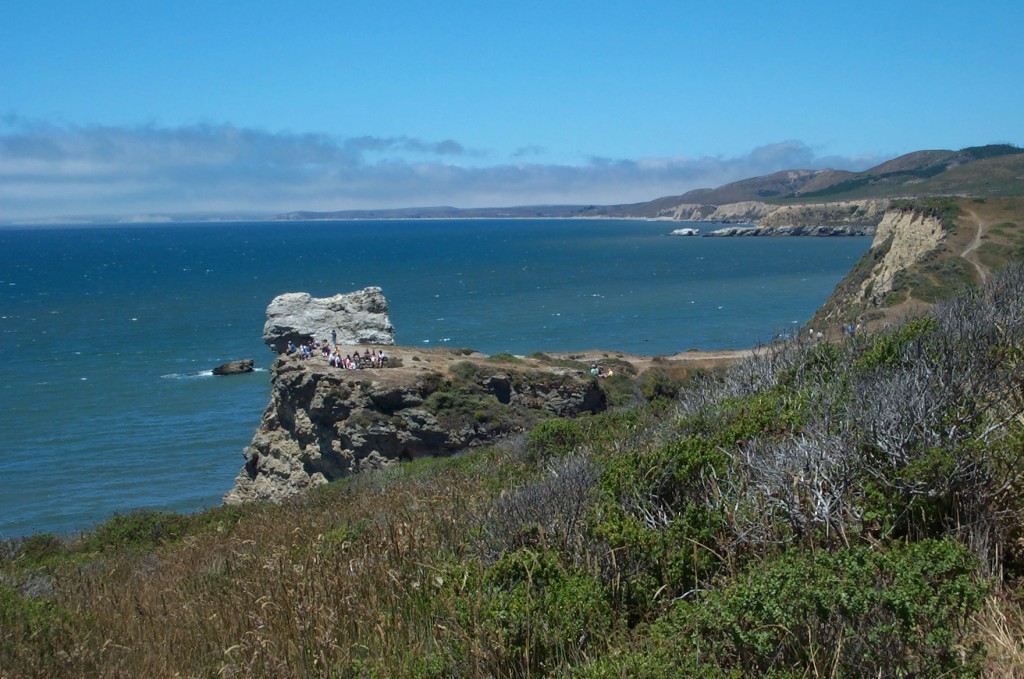05/22/2014
With a prime view of the rolling pastures that flank Tomales Bay and fall directly under their jurisdiction, the members of the California Coastal Commission voted last week to unanimously approve the county’s land use plan for its Local Coastal Program. The approval came despite concerns from some commissioners over how intergenerational housing would be regulated, along with protests from the public over the right to appeal agricultural housing directly to the commission.
The most extensive debate on Thursday surrounded intergenerational housing, both whether it should be appealable to the commission and how the commission will ensure such housing is occupied by next-generation farmers.
Intergenerational housing was one of the biggest requests made by the agricultural community; currently, only one house is allowed on farms and ranches in the coastal zone. That restriction, advocates of agriculture say, makes it difficult for farming families who want to encourage their children to take on the tradition or co-run businesses. Running or co-running a ranch is difficult without living on the land, and it can force retired farmers to leave their life-long homes to make room for their sons and daughters.
The proposed land use plan allowed for one farmhouse owned and occupied by the farm operator and one intergenerational house as a “principally permitted use,” meaning that although it could be appealed to the county’s Planning Commission and Board of Supervisors, it could not be appealed to the commission.
Still, such permits could be appealed if they lie within a geographic “appeal area”—between the sea and the first public road or 300 feet inland, or within 100 feet of streams and wetlands—where everything is appealable.
A second intergenerational home would be allowed as a conditional use on parcels of 180 acres or more, though the cumulative square footage of all homes would be capped at 7,000 square feet.
Jack Liebster, the planning manager for the county, addressed concerns aired over the last week by environmental groups over the total cumulative amount of development that would be allowed on agriculturally zoned land. He presented slides that showed the proportion of acreage that could be developed as a tiny dot on a large projector screen of verdant landscape.
Still, a number of locals protested the changes on Thursday, arguing the public should have the right to appeal directly to the commission, regardless of a project’s location. That ability can act as a firewall, they said, in case the policy shift opens an unintentional backdoor to the construction of weekend compounds accompanied by minimal agricultural use. The make-up of county staff, the Planning Commission and the Board of Supervisors will change over time, they said, so the document needs to restrain anyone in the future who might be friendlier to development.
“I think we have an immense responsibility [to consider] unintended consequences,” said Ann Baxter, of Inverness.
Amy Trainer, the executive director of the Environmental Action Committee of West Marin, also protested the new allowances for houses on agricultural lands. “We support family farms and the right for them to build some new development as it’s needed…but the public has always had the right to seek review from the coastal commission from residential development in the agricultural zone.” Ms. Trainer stressed her support for ranchers in West Marin and said she was not trying to make their lives difficult. “I like them. They’re cowboys, they’re really cool,” she said.
But farmers and ranchers protested the framing of the conversation, feeling their calls for a sustainable future had been maligned and their need for housing presented as pernicious.
Peter Martinelli, an organic vegetable farmer from Bolinas, lamented that agriculturalists had been “straddled” with the language of development. “We live on the land generationally…if we don’t take care of the resources there, we can’t farm. The fertility goes away.”
Chileno Valley rancher Sally Gale also spoke up. “I am dismayed by some of the comments I’ve heard by the so-called environmentalists,” said Ms. Gale, who raises grass-fed cows and lambs and grows apples with her husband, Mike. She said she supported the provision for intergenerational housing—including the square footage cap imposed on it.
Look at the hills, she asked the room. “We are the ones that have kept them green…we are the ones that make the grass productive and we provide the grazing animals that keep everything in balance.”
Sam Dolcini, the president of the Marin County Farm Bureau, urged commissioners to adopt the document, illustrating his arguments with a string of colorful metaphors. West Marin, he explained, is a beautiful tapestry created with trust and healthy tension, but some might be pulling so hard on it so as to turn it into a heap of threads. The L.C.P. itself is like a box of hard nails, which could be used to build agriculture or secure its coffin.
The farm community, Mr. Dolcini went on, has been critical to preserving West Marin for decades. “We, the family farmers and ranchers of West Marin, feel that we have brought you this far. So we just have one request: Please dance with the one who brought you to the ball…please let us keep dancing this celebratory waltz that has gone on for generations.”
In the debate over principally permitted uses, Charles Lester, the executive director of the commission, explained to the crowd and commissioners that those uses are intended to protect what the land is zoned for: its primary purpose. Uses are conditional when they don’t meet that standard.
The commission designated an intergenerational home as a principal use—while, for instance, making bed and breakfasts or homestays on ranches as a conditional use—because the county made the case that living on the land is not only necessary for Marin’s agriculture, but should be defined as agriculture itself. “The question is, for [the commissioners], do you agree with this analysis and determination for need of intergenerational housing?” he asked.
In addition to the public’s concern about appeals, some commissioners also worried about who could legally occupy the intergenerational homes. Commission staff believed that farm operators could authorize who lives in intergenerational homes, but could not legally require occupants to be family members.
Mary Shallenberger, a commissioner from Clements, expressed serious reservations about including intergenerational housing as a principal use, given her staff’s interpretation of housing law. But Steve Kinsey, the chair of the commission and West Marin’s county supervisor, argued against any last-minute changes. “I think we need to keep it exactly where it is,” he said, noting the substantial siting, sizing and clustering requirements that are already in place for housing.
The county counsel, David Zaltsman, did not agree with the commission’s finding that a familial requirement would be illegal, arguing that the county does have discretion to establish conditions on coastal permits to require familial occupancy and can refuse to grant permits if those conditions aren’t met.
By the end of the meeting, intergenerational housing remained a principal use, though the county and commission staffs said the implementation plan could be more specific when describing occupancy restrictions.
Commercial processing
The new land use plan designates commercial processing facilities of up to 5,000 square feet as a principal use on agricultural lands. Currently, those facilities are conditional uses. Commission staff had modified the county’s original request by adding the condition that facilities could only process products sourced on the farm itself.
But during public comment, David Lewis, the director of the University of California Cooperative Extension in Marin, pointed out that some creameries source milks from nearby farms—for instance, a cow dairy might purchase some sheep’s milk to make a blended-milk cheese. Fred Smith, a former executive director of the E.A.C, argued that allowing for products sourced around Marin might reduce the number of processing facilities.
The commissioners, in their only modification to the L.C.P., voted unanimously to allow operators to source products from within the “farmshed,” somewhat loosely defined as Marin and nearby Sonoma. (Mr. Liebster became so excited that he clapped, unaccompanied by anyone, after the vote was taken.)
Viticulture
Mirroring a debate that took place at the county level during L.C.P. hearings, commissioners called for a vote on whether viticulture should be demoted to a conditional agricultural use. The county decided that, given the soil, water availability and climate of coastal Marin, the conversion of vast swaths of grazing lands to vineyards was unlikely. But last Thursday some were skeptical of basing a policy decision on probabilities, particularly given the uncertainty of how climate change might impact weather patterns.
Dayna Bochco, a commissioner who lives part-time in Napa, said, “I would feel sickened if I looked out that window and all I saw were vines…Viticulture is different than any other kind of farming. Viticulture is its own world, it creates its own culture,” she said.
But others warned of the consequences of picking out preferred types of agriculture in L.C.P.s, since state code lists vines as a primary type of agriculture. “I don’t like them but I could also not like lemon orchards or pumpkin fields,” said Martha McClure, a commissioner from Del Norte County.
The vote on the amendment failed, but barely, at a 5-7 split.
Coastal hazards
One major update to the L.C.P. was the addition of sea-level rise as a distinct coastal hazard. But the county questioned coastal commission staff modifications that would have prevented existing development directly on the shoreline from using protective devices—such as seawalls or raised piers—to prove their stability.
Staff originally recommended that if a building could not prove its inherent stability, it should not get a coastal permit for significant additions or renovations. Later, recognizing that the commission itself recently approved many of the elevation devices it proposed to penalize—and given the county’s fears over making major renovations in places like Stinson Beach and Seadrift impossible for homeowners—the commission decided to allow homes located on shorelines to rely on existing piers or caissons to prove their stability.
That provision, however, sunsets in 2017; in the meantime, the county will undertake a multi-year evaluation of the impact of sea-level rise on Marin’s coast, a project funded in part by grants from the commission and the California Ocean Protection Council. That will result in an amendment to the L.C.P, to be submitted in 2017, which will more permanently address how to regulate shoreline development.
Visual resources
Many of the protections for visual resources are carried over from the 1982 L.C.P., including a 25-foot height restriction on development. More protections were implemented for visually prominent ridgelines; development is now prohibited “on top of, within 300 feet horizontally, or 100 feet vertically” of them.
Sensitive habitat areas
The new L.C.P. also shifts regulations for protective buffer areas around environmentally sensitive habitat areas, or ESHAs. Those areas are now divided into three categories: wetlands and streams, riparian habitat and terrestrial habitat like dunes. The 100-foot buffers of the certified L.C.P. around wetlands and streams can now be made larger or smaller, depending on a newly required biological site assessment for projects within or adjacent to those areas. A new 50-foot buffer for a terrestrial ESHA, which didn’t previously exist, can also be reduced to 25 feet.
Though the buffer reductions require a net environmental improvement, Ms. Trainer of the E.A.C. feared that allowing reductions could make those reductions the rule, not the exception. Although Ms. Shallenberger shared her fears, the language remained as is.

